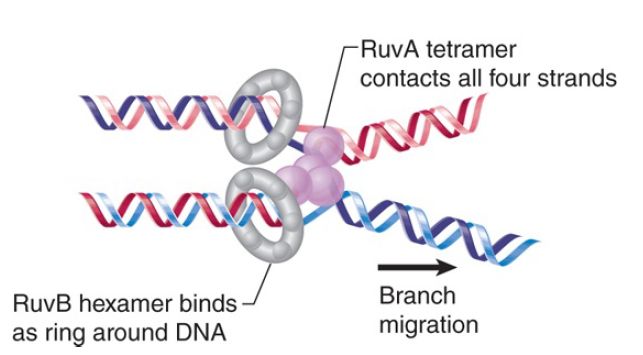
Holliday Junctions Must Be Resolved
 المؤلف:
JOCELYN E. KREBS, ELLIOTT S. GOLDSTEIN and STEPHEN T. KILPATRICK
المؤلف:
JOCELYN E. KREBS, ELLIOTT S. GOLDSTEIN and STEPHEN T. KILPATRICK
 المصدر:
LEWIN’S GENES XII
المصدر:
LEWIN’S GENES XII
 الجزء والصفحة:
الجزء والصفحة:
 16-4-2021
16-4-2021
 3210
3210
Holliday Junctions Must Be Resolved
KEY CONCEPTS
- The bacterial Ruv complex acts on recombinant junctions.
- RuvA recognizes the structure of the junction.
- RuvB is a helicase that catalyzes branch migration.
- RuvC cleaves junctions to generate recombination intermediates.
- Resolution in eukaryotes is less well understood, but a number of meiotic and mitotic proteins are implicated.
One of the most critical steps in recombination is the resolution of the Holliday junction, which determines whether there is a reciprocal recombination or a reversal of the structure that leaves only a short stretch of hybrid DNA . Branch migration from the exchange site determines the length of the region of hybrid DNA (with or without recombination).
The proteins involved in stabilizing and resolving Holliday junctions have been identified as the products of the ruv genes in E. coli. RuvA and RuvB increase the formation of heteroduplex structures. RuvA recognizes the structure of the Holliday junction. RuvA binds to all four strands of DNA at the crossover point and forms two tetramers that sandwich the DNA. RuvB is a hexameric helicase with an ATPase activity that provides the motor for branch migration. Hexameric rings of RuvB bind around each duplex of DNA upstream of the crossover point. A diagram of the complex is shown in FIGURE 1.

FIGURE 1. RuvAB is an asymmetric complex that promotes branch migration of a Holliday junction.
The RuvAB complex can cause the branch to migrate as fast as 10 to 20 bp per second. A similar activity is provided by another helicase, RecG. RuvAB displaces RecA from DNA during its action. The RuvAB and RecG activities both can act on Holliday junctions, but if both are mutant, E. coli is completely defective in recombination activity.
The third gene, ruvC, encodes an endonuclease that specifically recognizes Holliday junctions. It can cleave the junctions in vitro to resolve recombination intermediates. A common tetranucleotide sequence provides a hotspot for RuvC to resolve the Holliday junction. The tetranucleotide (ATTG) is asymmetric, and thus may direct resolution with regard to which pair of strands is nicked. This determines whether the outcome is patch recombinant formation (no overall recombination) or splice recombinant formation (recombination between flanking markers). Crystal structures of RuvC and other junction-resolving enzymes show that there is little structural similarity among the group, in spite of their common function.
We may now account for the stages of recombination in E. coli in terms of individual proteins. FIGURE 2. shows the events that are involved in using recombination to repair a gap in one duplex by retrieving material from the other duplex. The major caveat in applying these conclusions to recombination in eukaryotes is that bacterial recombination generally involves interaction between a fragment of DNA and a whole chromosome. It occurs as a repair reaction that is stimulated by damage to DNA, but this is not entirely equivalent to recombination between genomes at meiosis. Nonetheless, similar molecular activities are involved in manipulating DNA.

FIGURE 2. Bacterial enzymes can catalyze all stages of recombination in the repair pathway following the production of suitable substrate DNA molecules.
All of this suggests that recombination uses a “resolvasome” complex that includes enzymes catalyzing branch migration as well as junction-resolving activity. It is possible that mammalian cells contain a similar complex.
Although resolution in eukaryotic cells is less well understood, a number of proteins have been implicated in mitotic and meiotic resolution. S. cerevisiae strains that contain mus81 mutations are defective in recombination. Mus81 is a component of an endonuclease that resolves Holliday junctions into duplex structures. The resolvase is important both in meiosis and for restarting stalled replication forks . Other proteins known to be involved in the resolution process are described in the broader context of eukaryotic homologous recombination factors in the following section.
 الاكثر قراءة في مواضيع عامة في الاحياء الجزيئي
الاكثر قراءة في مواضيع عامة في الاحياء الجزيئي
 اخر الاخبار
اخر الاخبار
اخبار العتبة العباسية المقدسة


